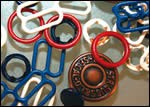If you’re looking to coat large quantities of small parts, your processing options are fairly limited. Dipping or dip-spin are popular but both can have difficulty producing a consistent coating thickness over the surface of some part geometries.
Enter Rotamat, a machine/process from Walther Trowal GmbH and Co KG (Grand Rapids, MI). Popular for coating small components throughout Europe, the process is just starting to be applied in the U.S. It combines a rotating barrel similar to that found on a mass finishing machine with paint spray guns.
The process works by spinning randomly oriented small parts beneath the spray nozzle or nozzles, enabling even paint coverage on all areas of the parts. Walther says it works on a variety of part geometries, but is especially well suited for parts with geometry or crevices. An example is Phillips head screws, where the head might tend to clog with coating material in a dip-spin operation.
Depending on the model, the machine can handle any of four interchangeable barrels with
capacities from 1–50 L. The barrel can be placed at inclinations 0–35°, and inclines to 125° in the other direction to allow easy unloading of parts.
It rotates at speeds from 2–30 rpm. Processing temperatures range to 300°F depending on parts and the finish being applied.
Walther says the machine can handle parts to about 4 inches in diameter. Process parameters, including barrel angle and rotation speed, air temperature and flow, and spray parameters must be developed for each part size, weight and configuration, but once a process is developed the machine’s PLC provides automated process control. Up to four machines can be linked and operated from a single control. Although the Rotamat barrel looks similar to that of a typical tumbling barrel, Walther says its elliptical cross section is designed to throw parts riding near the outside edge of the drum into the center and under the machine’s spray guns.
In a typical process, parts are loaded and started tumbling slowly. They’re heated until they reach the desired processing temperature, then sprayed to develop multiple, very thin layers of the finishing material being applied. Coatings can be solvent- or water-based, and Walther says the process has been proven with lacquers, epoxies, and a variety of water-based paint materials as well as rust preventatives, lubricants and other materials.
Once the desired coating thickness has been achieved, the machine heats prefiltered inlet air to 300°F to speed drying. Exhaust air is removed from the drum with a suction fan, and the drum can then be tilted downward for easy part removal. Walther says parts with coatings that require higher cure temperatures can be post-processed using any desired curing technique.
Multi-step coatings—for example, a base paint followed by another material to give an aged or patina appearance—can be applied in a single process using two guns. Walther says this illustrates a key aspect of operating the Rotamat machines: labor savings.
If needed, the barrel internal surface can be cleaned using special elliptical media supplied by Walther. But, the company says, if processors run consistent batch sizes there should be very little need for barrel cleaning.
In addition to decorative coatings, the process can be used to apply anti-blocking agents to reduce the coefficient of friction of small parts. A typical application in this area is sealing rings used in many assemblies in the automotive and other industries.
The process also works to prepare part surfaces for application of adhesives using conventional primers to improve surface tension of parts and boost adhesion, and for coating of parts for electrical insulation. Example application in this area include coating of ferrite cores and core discs for small electric motors.
Related Content
Finishing Systems Provider Celebrates 150 Years, Looks to Future
From humble beginnings as an Indiana-based tin shop, Koch Finishing Systems has evolved into one of the most trusted finishing equipment providers in the industry.
Read MoreIntumescent Coating Provides Up to 3 Hours of Fire Protection
PPG Steelguard 951 coating is designed to provide protection against fire and corrosion.
Read MoreHenry Ford Is Still Right When It Comes to Color
Who would have imagined that more than 100 years after his famous statement about any color as long as it’s black would still have relevance of a sort?
Read MoreMasking Solutions Provider CFS Dramatically Expands Capabilities and Capacity
Custom Fabrication & Supplies (CFS) completed a new plant expansion packing 10 times the capacity into twice the space. It dramatically enhances the supplier’s custom capabilities to provide extremely precise and cost-effective masking solutions.
Read MoreRead Next
Episode 45: An Interview with Chandler Mancuso, MacDermid Envio Solutions
Chandler Mancuso, technical director with MacDermid Envio discusses updating your wastewater treatment system and implementing materials recycling solutions to increase efficiencies, control costs and reduce environmental impact.
Read MoreDelivering Increased Benefits to Greenhouse Films
Baystar's Borstar technology is helping customers deliver better, more reliable production methods to greenhouse agriculture.
Read MoreEducation Bringing Cleaning to Machining
Debuting new speakers and cleaning technology content during this half-day workshop co-located with IMTS 2024.
Read More























